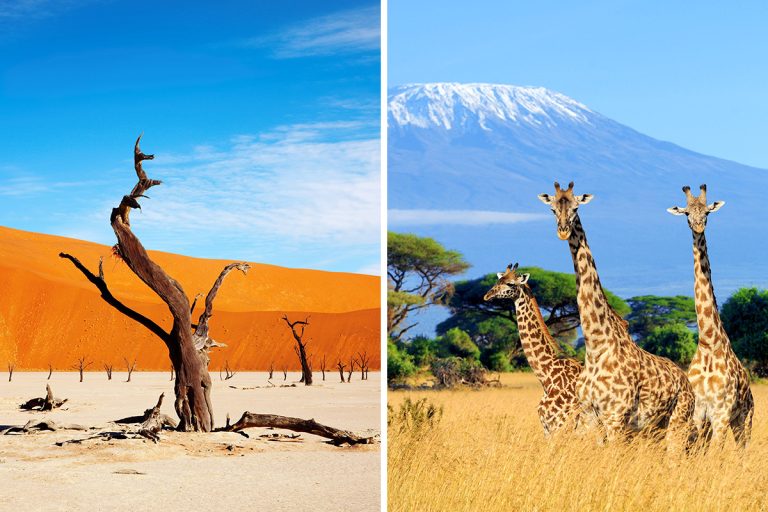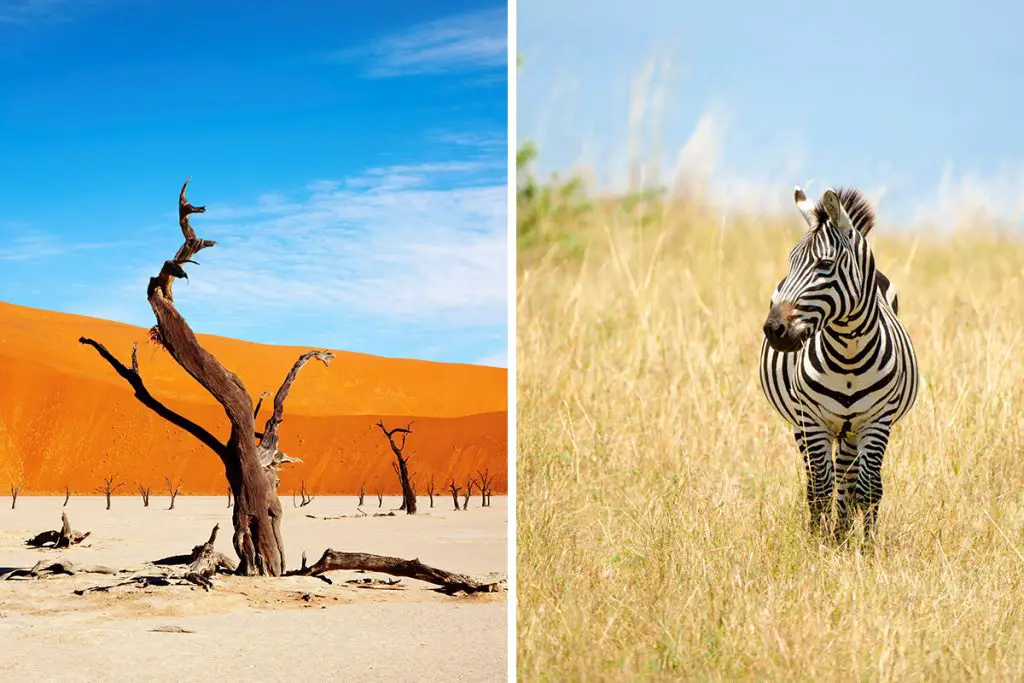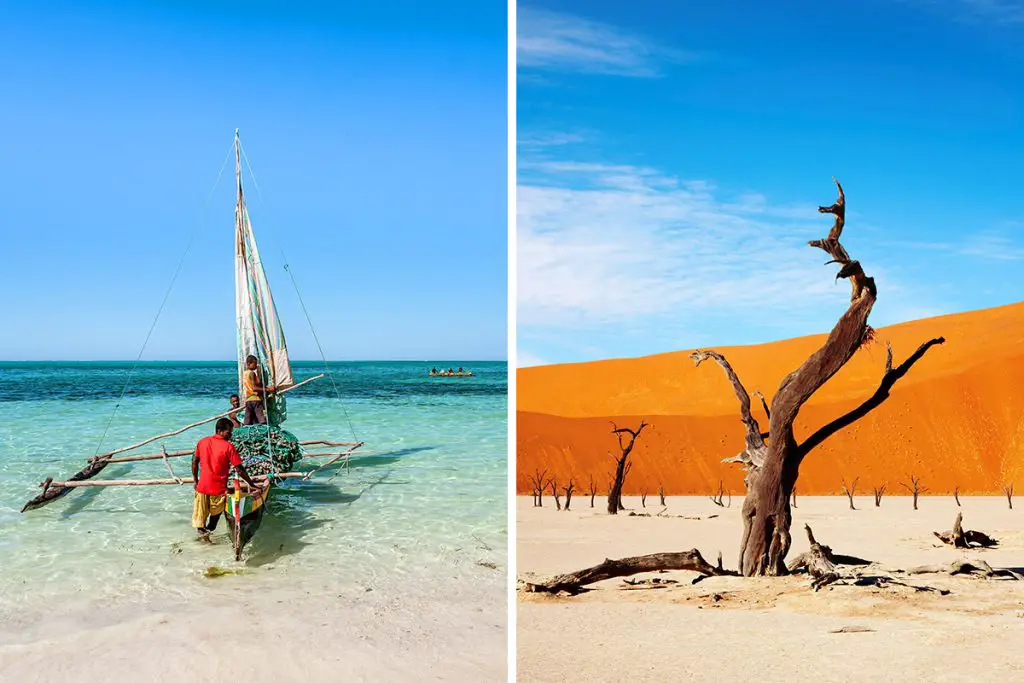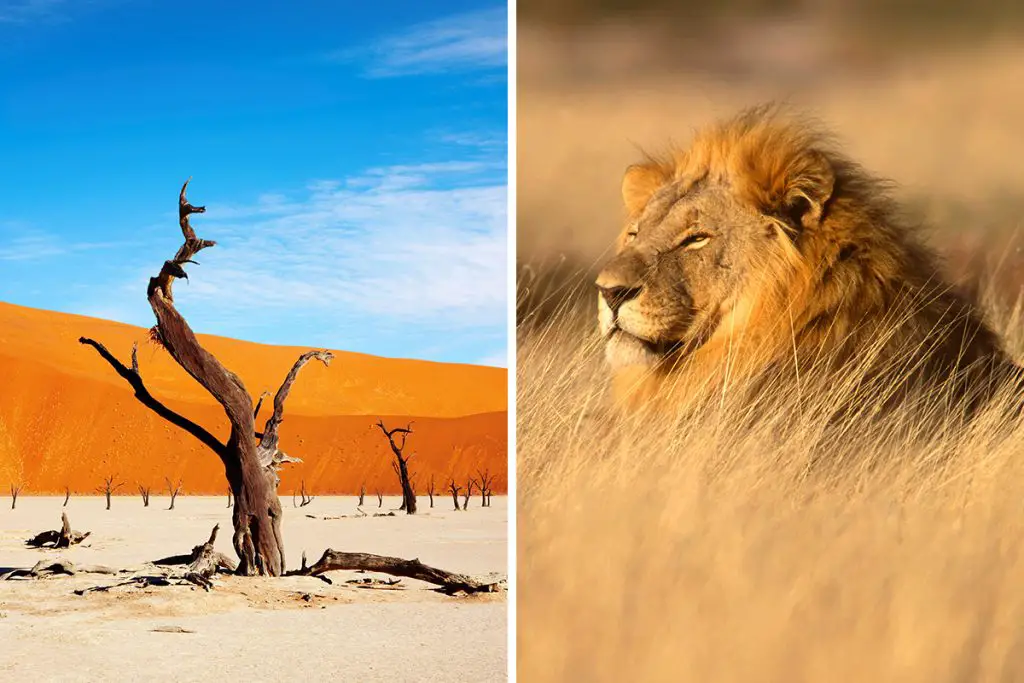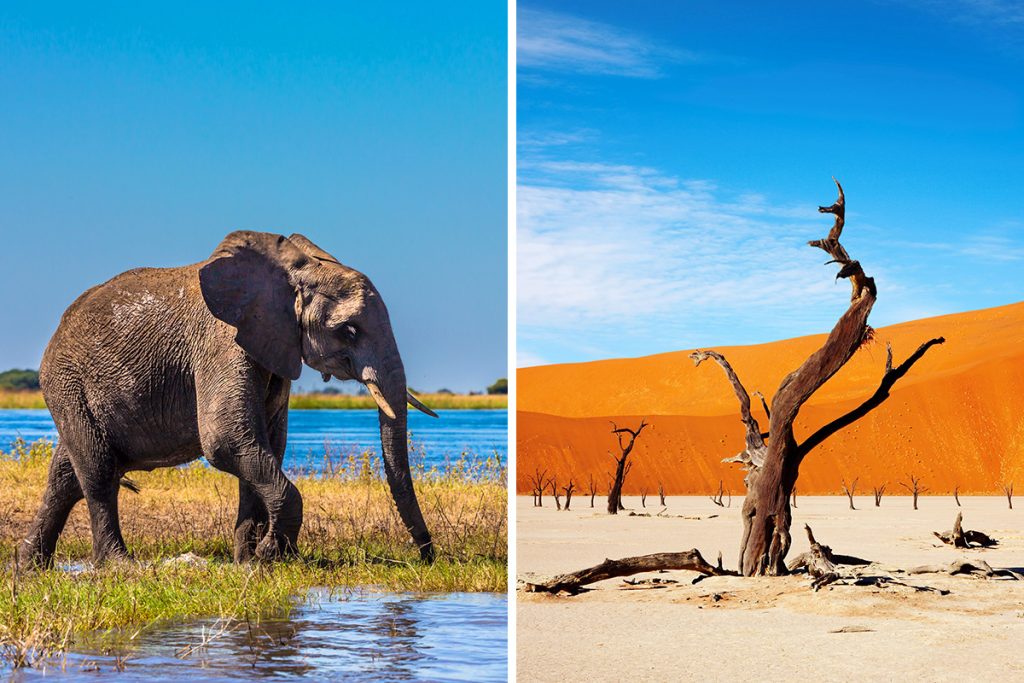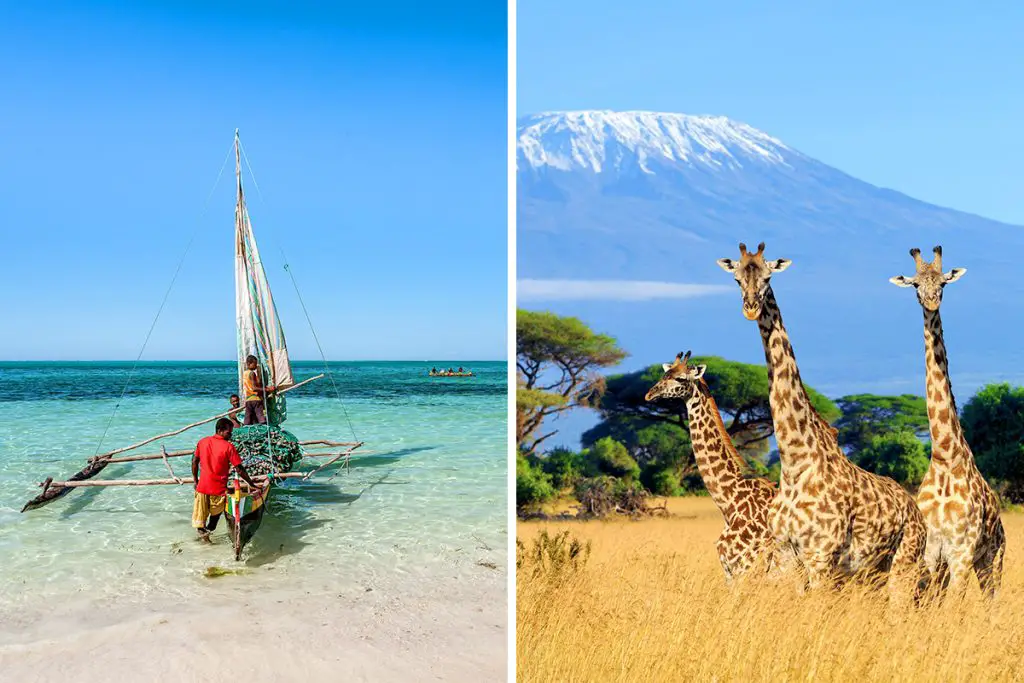Making your pick between Namibia and Tanzania might feel like being asked to choose your favorite color from a vivid rainbow. Each one has its own allure, from Namibia’s sweeping desert vistas to Tanzania’s lively towns filled with music and dance. Stick around, and together, we’ll uncover the history and culture these incredible destinations offer.
History & Culture
Diving headfirst into the tapestry of history and culture, let’s embark on a journey through time, first stopping in Namibia.
This country, like a beautiful mosaic, is pieced together by a fascinating blend of cultures, with roots traced back to ancient African tribes. Here, the legacy of the San, Damara, and Herero tribes enriches the cultural landscape, weaving a story of resilience and survival through centuries of change.
What’s striking about Namibia is the seamless blend of past and present, where ancient traditions continue to resonate in the modern world.
In contrast, Tanzania tells a different but equally compelling story. The cradle of humanity, Tanzania is renowned for the Olduvai Gorge, where some of the earliest human ancestors made their mark.
Yet, the cultural tapestry doesn’t end there. Arab, Bantu, and European influences have since left their imprints, resulting in a cultural cocktail that’s as diverse as it is engaging. Tanzanian culture is a celebration of diversity, a testament to the country’s rich and varied past.
But what about the shared history of these two nations? Both countries have walked the path of colonial rule, with Namibia under German and South African administration, and Tanzania shaped by German and British influence. These experiences have left their mark, visible in architectural styles, languages spoken, and societal structures.
Comparing Namibia and Tanzania is like examining two sides of a historical coin, each bearing unique etchings and symbols, each echoing stories of bygone eras and cultural evolution.
The history and culture of Namibia is a tale of enduring tribes and colonial impact, painting a vibrant picture of resilience and cultural preservation. On the other hand, Tanzania is a song of cultural diversity, a symphony of voices representing a broad spectrum of influences that contribute to the country’s vibrant character.
To sum it up, whether you’re fascinated by the ancient tribal legacy of Namibia or drawn towards the melting pot of cultures in Tanzania, both destinations serve up a feast of historical and cultural delights. Which one tugs at your heartstrings the most? Only you can answer that.
Attractions & Activities
If history and culture are the heartbeat of a country, then attractions and activities are its vibrant personality. When it comes to Namibia and Tanzania, both destinations have something unique to offer.
Namibia is a paradise for outdoor enthusiasts. The towering red dunes of the Namib Desert offer spectacular opportunities for unique desert safaris and photography, while the majestic Etosha National Park teems with wildlife like elephants, lions, and rhinos, offering an unforgettable African safari experience.
Plus, the hauntingly beautiful Skeleton Coast, dotted with shipwrecks, is an adventurer’s dream, boasting endless opportunities for exploration.
In contrast, Tanzania pulsates with natural wonders. The Serengeti National Park, a UNESCO World Heritage site, sets the stage for the annual Great Migration, one of nature’s most thrilling spectacles.
Plus, Mount Kilimanjaro, the highest peak in Africa, beckons climbers from around the globe, while the expansive Ngorongoro Crater offers a unique wildlife viewing experience in the world’s largest inactive volcanic caldera.
When it comes to urban attractions, both countries have their highlights. Windhoek, the capital of Namibia, fascinates visitors with its blend of modern and German colonial-era architecture. Dar es Salaam, Tanzania’s largest city, showcases a bustling harbor and vibrant markets, bringing to life the local culture and economy.
Comparing attractions and activities in Namibia and Tanzania, it’s clear that both offer unique experiences. From the haunting beauty of Namibia’s deserts to Tanzania’s dynamic wildlife and natural wonders, each destination presents an unforgettable journey.
To summarize, if the allure of desert landscapes and intimate wildlife encounters draws you in, then Namibia’s attractions and activities will satisfy your adventure-seeking spirit. Alternatively, if witnessing one of nature’s greatest spectacles and exploring breathtaking natural landscapes excite you, Tanzania will exceed your expectations.
Beaches
Let’s shift gears and dip our toes into the topic of beaches. Namibia and Tanzania, each with its coastline, offer distinctly different beach experiences.
Namibia, with its coastline along the Atlantic Ocean, has beaches that are wild and rugged. Places like Swakopmund offer stunning coastal landscapes, where the desert meets the sea. However, due to the chilly Benguela Current, the waters are rather cold, averaging around 56°F (13°C), making them more suitable for scenic walks and photography than swimming.
On the other side, Tanzania, flanked by the Indian Ocean, is blessed with warmer beaches such as those in Zanzibar. Here, powdery white sands and turquoise waters create a tropical paradise, with average water temperatures around a balmy 81°F (27°C), perfect for swimming and snorkeling.
One commonality between the two is the breathtaking sunsets they offer. Whether it’s the sun descending over Namibia’s wild beaches or the vibrant colors painting the Tanzanian skies, the spectacle is nothing short of magical.
So, whether you’re looking for rugged beauty in Namibia or warm tropical waters in Tanzania, both destinations offer unique beach experiences.
In conclusion, the wild and rugged beaches of Namibia are ideal for scenic views and photography. However, if warm waters and white sandy beaches are what you’re after, Tanzania’s coastline offers an inviting, tropical haven. Where would you like to soak in a magical sunset?
Eating, Drinking & Nightlife
A destination’s flavor, its thirst-quenching offerings, and its nighttime pulse can add a whole new dimension to your travel experience. When contrasting Namibia and Tanzania in terms of eating, drinking, and nightlife, you’ll find a captivating blend of differences and similarities.
Namibian cuisine is a reflection of the country’s ethnic diversity. Staple foods like millet and maize porridge are commonly paired with meats and fish, and you’ll also find German-inspired dishes, a vestige of the country’s colonial past.
On the other hand, Tanzanian cuisine offers a delightful fusion of native African, Arabic, and Indian influences. Ugali (maize porridge) and Nyama Choma (grilled meat) are typical dishes you’d find across the country.
As for drinks, Namibia offers a unique twist. Thanks to German influence, you’ll find excellent locally brewed beers that are well worth a try. Tanzania, on the other hand, serves up traditional drinks like Chai tea and local brews like banana beer. Whether you’re a beer enthusiast or a tea lover, both countries provide an authentic taste of their local beverage scene.
When it comes to nightlife, both countries have their own rhythm. Namibia’s nightlife, primarily in cities like Windhoek, includes live music and dancing in local clubs, offering a chance to mix with locals. In Tanzania, especially in cities like Dar es Salaam and Arusha, the nightlife is lively with local music, dancing, and bustling night markets.
In essence, whether you’re sampling a hearty Namibian meal, sipping on Tanzanian Chai, or grooving to the local beats, both countries offer a tantalizing array of eating, drinking, and nightlife options. Which country’s culinary scene and nighttime pulse align more with your preferences?
Shopping
A country’s markets and shops offer a glimpse into its heart, reflecting local culture, craft, and creativity. As you delve into the shopping scenes in Namibia and Tanzania, you’ll encounter a rich diversity of souvenirs, art, and unique finds.
Namibia is known for its high-quality gemstones and jewelry, especially pieces featuring locally mined diamonds and semi-precious stones. Beautifully carved wooden sculptures, handwoven baskets, and Namibian craft beer are among other favorite buys.
In cities like Windhoek, you’ll find well-stocked shopping malls and vibrant local markets like the Namibia Craft Centre, showcasing the finest local craftsmanship.
Tanzania, on the other hand, offers an array of unique shopping experiences. Vibrant fabrics known as ‘Khangas’ and ‘Kitenges’, intricately carved Makonde wood sculptures, and precious Tanzanite stones are among the top purchases. You’ll also find a rich selection of spices, especially in Zanzibar, known as the ‘Spice Island’.
The bustling markets of Dar es Salaam, like Kariakoo Market, offer a sensory overload of sights, sounds, and smells, presenting a unique shopping experience.
To sum up, both Namibia and Tanzania offer rewarding shopping experiences, each with its own unique flair. Whether you’re seeking sparkling gemstones and intricate handicrafts in Namibia or vibrant textiles, aromatic spices, and exquisite wood carvings in Tanzania, both countries promise a shopping experience you’ll cherish. Which country’s markets are calling you to explore?
Accommodation
When it comes to resting your head after a day of adventure, the right accommodation can make all the difference. Both Namibia and Tanzania offer a wide array of choices to suit different tastes and budgets.
Namibia’s accommodation options are as diverse as its landscape. From luxury lodges nestled amidst the stunning dunes of the Namib Desert to cozy guesthouses in Windhoek, there’s a perfect spot for everyone. For wildlife lovers, there are numerous safari lodges and camps in places like Etosha National Park, where the African wilderness is right at your doorstep.
In Tanzania, the accommodation scene is equally varied. Upscale resorts in Zanzibar, with their pristine beaches and azure waters, are a dream for beach lovers.
For those heading for a safari in Serengeti or climbing Kilimanjaro, there are various lodges, camps, and budget-friendly hostels that cater to different needs. In urban areas like Dar es Salaam, you’ll find a mix of luxury hotels and affordable guesthouses.
In conclusion, both Namibia and Tanzania offer a range of accommodation options to suit different needs and budgets. Whether you prefer a luxury lodge, a cozy guesthouse, a safari camp, or a beach resort, you’ll find a perfect spot to rest and rejuvenate.
Family-Friendliness & Children’s Activities
Family travel is all about creating unforgettable memories together. When comparing Namibia and Tanzania for family-friendliness and children’s activities, each presents unique offerings that make for an enriching family vacation.
In Namibia, you’ll find activities that are both educational and fun. A visit to the Namib Desert can turn into a fascinating geography lesson, while wildlife safaris in Etosha National Park are a great way to spark a love for nature and conservation in young minds. Many lodges and camps also offer children’s programs with activities like bushcraft lessons and animal tracking.
On the other hand, Tanzania is an adventurer’s playground for children and adults alike. The wildlife safaris in Serengeti or the Ngorongoro Crater are an absolute thrill for kids. A visit to Zanzibar offers plenty of beach fun and opportunities to learn about the local culture and history. Moreover, many resorts and lodges have specialized kids’ clubs and programs.
To summarize, both Namibia and Tanzania offer a wealth of family-friendly activities and accommodations. Whether it’s exploring the world’s oldest desert in Namibia or witnessing the Great Migration in Tanzania, both destinations offer enriching experiences for children and adults alike.
Getting There & Getting Around
The journey can be as rewarding as the destination itself. Whether you’re mapping your route to Namibia or Tanzania or figuring out the best way to navigate around, each country offers its own unique set of challenges and rewards.
Getting to Namibia often involves a long flight, as the Hosea Kutako International Airport in Windhoek, located approximately 5,000 miles (8,000 kilometers) from major US cities, is the main international gateway. From Europe, the distances are a bit shorter.
In comparison, reaching Tanzania from the US involves slightly longer air travel, with Julius Nyerere International Airport in Dar es Salaam and Kilimanjaro International Airport being the main points of entry. The distance is approximately 7,500 miles (12,000 kilometers) from major US cities.
Once you’re there, getting around Namibia is often best done by car, as the country has a well-maintained road network. A 4×4 is recommended for off-road adventures. Alternatively, domestic flights can connect you to major towns and tourist sites.
In Tanzania, getting around can be a bit more complex due to its larger size and diverse terrain. Domestic flights are often the fastest and most convenient option to travel between major cities and tourist attractions. For shorter distances, local buses, known as ‘dala-dala’, are a common, albeit crowded, mode of transport.
In essence, while the journey to Namibia or Tanzania can be lengthy, each offers a variety of options for getting around, whether it’s by car, domestic flight, or local bus. Your adventure begins the moment you set off on your journey.
Weather
When planning your adventure, the weather plays a key role. Let’s compare the climates of Namibia and Tanzania to help you decide the best time to visit each.
Namibia, mostly a desert country, is known for its year-round sunshine. The winter months from May to September offer mild temperatures, averaging between 68°F (20°C) during the day and dropping to around 41°F (5°C) at night. Summers from November to March can get quite hot, with temperatures soaring up to 104°F (40°C) in the interior.
Contrarily, Tanzania has a tropical climate with two distinct seasons. The dry season from June to October sees daytime temperatures hover around 77°F (25°C) and nighttime temperatures drop to 59°F (15°C). The rainy season from November to May is characterized by higher humidity and temperatures, often reaching up to 86°F (30°C).
To sum up, Namibia’s desert climate offers year-round sunshine and hot summers, while Tanzania’s tropical climate presents a warmer, humid rainy season and a cooler dry season. Considering the weather, you can plan your visit to make the most of your journey.
Safety
Safety is paramount when it comes to traveling. So let’s discuss the safety aspects of both Namibia and Tanzania.
Namibia is generally regarded as a safe country for tourists. The capital city, Windhoek, and major tourist destinations like Etosha National Park and Swakopmund maintain good security standards. Nevertheless, like anywhere, it’s important to remain vigilant against petty crimes such as pickpocketing and bag snatching.
Similarly, Tanzania, particularly the tourist hotspots like Zanzibar, Serengeti, and Kilimanjaro, has a reputation for being safe for tourists. However, there can be occasional instances of petty theft, particularly in urban areas like Dar es Salaam.
In relation to health, it’s worth noting that both countries have regions where malaria is prevalent. Therefore, it’s essential to take preventive measures such as using mosquito repellents and considering prophylactic medication.
In conclusion, both Namibia and Tanzania generally have a good safety record for tourists. However, basic safety precautions and health measures should always be part of your travel plans.
Cost
How much your adventure will cost is a significant aspect of planning. Let’s compare the costs you can expect when visiting Namibia and Tanzania.
In Namibia, you can expect to pay around N$150 (about $8.40) for a budget meal, while a mid-range restaurant may charge around N$300 (about $16.80) per person. Accommodation can vary widely, with budget guesthouses costing around N$600 (about $33.60) per night, and luxury lodges going up to N$3000 (about $168).
In comparison, Tanzania can be slightly more expensive. A budget meal would cost around TSh 10,000 (about $4.10), and a mid-range meal could go up to TSh 30,000 (about $12.30). Budget accommodation starts at about TSh 60,000 (about $24.60) per night, and luxury resorts can charge up to TSh 300,000 (about $123).
As for transportation, car rentals in both countries start from around N$600 (about $33.60) in Namibia and TSh 120,000 (about $49.20) in Tanzania. Domestic flights can be a costlier option in both countries.
To wrap it up, both Namibia and Tanzania offer a range of price points, but overall, Namibia might be slightly more affordable, especially for food and accommodation. However, both countries offer options to suit different budget levels.
Which Is Better – Namibia or Tanzania?
Choosing between Namibia and Tanzania for your next vacation can be a tough decision. Both offer rich history and culture, unique attractions, and captivating natural beauty. However, your personal preferences will ultimately guide your choice.
Historically and culturally, both nations offer immersive experiences. Namibia, with its German influences, ancient rock art, and diverse tribal cultures, provides a unique cultural tapestry. Tanzania, on the other hand, with its Swahili culture, Maasai traditions, and historic sites like Stone Town, offers a different, but equally enriching cultural journey.
In terms of attractions and activities, Namibia’s vast landscapes such as the Sossusvlei sand dunes and Etosha National Park offer thrilling adventures for nature lovers and photographers. Tanzania counters with its world-renowned national parks like the Serengeti and Ngorongoro Crater, which are perfect for wildlife enthusiasts and safari lovers.
Namibia’s Skeleton Coast and Swakopmund offer wild and untamed beaches that are ideal for solitude seekers and adventure junkies. Tanzania’s Zanzibar, on the other hand, offers pristine, idyllic beaches perfect for relaxation and water activities.
Food, drink, and nightlife vary greatly in both countries. Namibia offers a hearty cuisine influenced by German and African cultures, and Windhoek has an enjoyable nightlife scene. Tanzania, with its Swahili cuisine and vibrant nightlife in Dar es Salaam and Zanzibar, is a gastronomic and social paradise.
Both countries offer a wide range of shopping experiences, from bustling markets to high-end boutiques. Namibia is known for its gemstones and crafts, while Tanzania is famed for its Maasai beads and Tanzanite jewelry.
Accommodation in both countries caters to various budgets, with Namibia generally offering more affordable options. Both nations are also known for their family-friendly activities and accommodations, making them ideal for family holidays.
Getting to and around these countries depends largely on your itinerary. Namibia’s well-maintained roads make self-driving a viable option, while Tanzania’s extensive flight network makes it easy to visit various parts of the country quickly.
The weather in Namibia is typically dry and sunny, making it a year-round destination. Tanzania’s weather varies seasonally, with the dry season being the best time to visit for wildlife viewing.
Safety in both countries is generally good, with the usual precautions recommended. Cost-wise, Namibia may be slightly more budget-friendly, but both countries offer options for various budgets.
To conclude, your choice between Namibia and Tanzania will largely depend on your personal preferences. For vast landscapes, German-influenced culture, and self-driving adventures, Namibia is your best bet. But if you’re after a safari paradise, Swahili culture, and idyllic beaches, Tanzania would be a perfect choice. Whichever you choose, an unforgettable adventure awaits.

